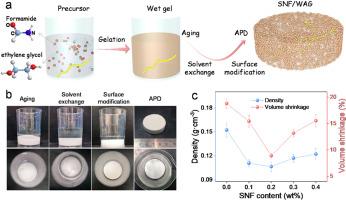Water glass-based aerogel monolith prepared with formamide catalyst and SiO2 nanofiber reinforcement: Nanoarchitectonics and enhanced mechanical property
IF 3.5
3区 化学
Q2 CHEMISTRY, INORGANIC & NUCLEAR
引用次数: 0
Abstract
Water glass-based aerogels (WAGs) are poor in mechanical properties, which seriously limits their application. At the same time, the strong acid used for the gelation of water glass is corrosive to equipment. In this work, water glass-based aerogel monolith with significantly improved mechanical property were prepared with flexible electrospun SiO2 nanofibers (SNF) as reinforcing agents and formamide (FA) as the hydrolysis catalyst (SNF/WAG). The introduced SNF can reduce the density and shrinkage of the aerogel, which are decreased to 8.9 % and 0.107 g cm−3 for the SNF/WAG-2, respectively. Most importantly, the introduction of SNF can transform the brittle structure of WAG into the plastic structure of SNF/WAG, improving its mechanical properties. The high adsorption capacity for CH2Cl2 (11.33 g g−1) enables SNF/WAG to serve as an efficient oil absorbent material. Owing to the low density, hydrophobicity and good insulation, the evaporator assembled with SNF/WAG as insulator exhibits evaporation rates of 1.932, 2.622, and 3.082 kg m−2 h−1 at 1, 2, and 3 sun illumination, and the evaporation rate can still be maintained at 1.728 kg m−2 h−1 after 5 cycles at 1 sun intensity. This study offers a feasible approach to overcome the key limitations of conventional water glass-based aerogels. It significantly enhances the overall material performance while maintaining low-cost preparation, thus paving the way for broader application of aerogels in areas such as high-strength thermal insulation.

甲酰胺催化剂和二氧化硅纳米纤维增强制备的水玻璃基气凝胶单体:纳米结构和增强的力学性能
水玻璃基气凝胶的力学性能较差,严重限制了其应用。同时,用于水玻璃凝胶化的强酸对设备有腐蚀性。以柔性电纺丝SiO2纳米纤维(SNF)为补强剂,甲酰胺(FA)为水解催化剂(SNF/WAG),制备了力学性能显著提高的水玻璃基气凝胶单体。SNF/WAG-2的密度和收缩率分别为8.9%和0.107 g cm−3。最重要的是,SNF的引入可以将WAG的脆性结构转变为SNF/WAG的塑性结构,提高其力学性能。SNF/WAG对CH2Cl2的高吸附量(11.33 g g−1)使其成为一种高效的吸油材料。以SNF/WAG为绝缘体的蒸发器由于密度低、疏水性好、绝缘性好,在1、2、3个太阳光照下,蒸发器的蒸发速率分别为1.932、2.622和3.082 kg m−2 h−1,在1个太阳光照强度下,5个循环后蒸发器的蒸发速率仍可保持在1.728 kg m−2 h−1。该研究为克服传统水玻璃基气凝胶的主要局限性提供了一种可行的方法。它在保持低成本制备的同时显著提高了材料的整体性能,从而为气凝胶在高强度保温等领域的更广泛应用铺平了道路。
本文章由计算机程序翻译,如有差异,请以英文原文为准。
求助全文
约1分钟内获得全文
求助全文
来源期刊

Journal of Solid State Chemistry
化学-无机化学与核化学
CiteScore
6.00
自引率
9.10%
发文量
848
审稿时长
25 days
期刊介绍:
Covering major developments in the field of solid state chemistry and related areas such as ceramics and amorphous materials, the Journal of Solid State Chemistry features studies of chemical, structural, thermodynamic, electronic, magnetic, and optical properties and processes in solids.
 求助内容:
求助内容: 应助结果提醒方式:
应助结果提醒方式:


